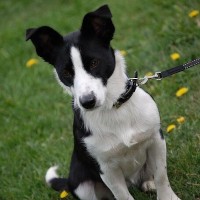Appearance of the Border Jack
|
| As a cross-breed dog, the Border Jack can inherit appearance traits from one or both of the breed's parents. Generally, the Border Jack's body is more like that of the Jack Russell Terrier, with its narrow body and chest, small head and floppy ears that flop forward. Your Border Jack may have dark oval or almond-shaped eyes, giving him an alert, intelligent expression. He'll probably have a strong muzzle with tight lips and a scissor bite. His feet may be round or oval, compact, with moderately arched toes that point forward, pads and thick, hard nails that are of moderate length. Your Border Jack is medium-sized, from 40.5 to 56 centimeters, and will weigh from 10 to 14.5 kilos. |
Temperament of the Border Jack
|
| Your Border Jack hybrid may adopt the temperament of one or both of its parent breeds, but rest assured that it will be brave, loyal and playful above all else. He loves his human family and will bond with them. He is very good with young and older children but, because he is so energetic and exuberant, he should not be left alone with young children. He is wary of strangers, but this trait can be modified using early socialization techniques. Early socialization should include not only humans but also other dogs and cats. He's exceptionally intelligent, which makes training easier than some other breeds, but it can take longer because he's such a busy dog. Since he has a working instinct, be prepared to keep him well exercised and mentally challenged. Keeping him well exercised and mentally challenged will help expend all that energy and prevent him from getting bored and destroying himself. |
Needs and activities of the Border Jack
|
| Your Border Jack has the propensity to have enormous amounts of energy to expend. He loves to run, jump, chase and play, and can do so for hours on end. He also loves to run with his human family, so if you're a runner, take him with you. He won't complain or have any trouble keeping up with you, and he'll love you more for it. For all his energy needs, he's a dog who can live happily in an apartment, provided you're prepared to provide plenty of exercise opportunities and playtime activities. He can live in any climate in both urban and rural environments, although extra protection may be required when outdoors in colder climates. He'll also do well in a family home with or without a fenced yard, again, provided he gets appropriate exercise. |
Maintenance of the Border Jack
|
| Your Border Jack is a moderate excretor, so he'll need moderate care and brushing. This will reduce excess hair in your home and keep it clean and free of debris. He should be brushed at least twice a week and bathed only when necessary. Following the brushing routine will reduce the amount of vacuuming you'll need and help reduce airborne irritants for members of your household who suffer from asthma or other respiratory problems. Your Border Jack should have his ears checked and cleaned if necessary at least once a week to reduce the risk of infection. He should have regular, routine eye examinations to monitor any eye problems known to afflict parent breeds. As with almost all other dog breeds, regular dental examinations and cleanings will help reduce the risk of periodontal disease leading to tooth loss. |









 English (United Kingdom)
English (United Kingdom)